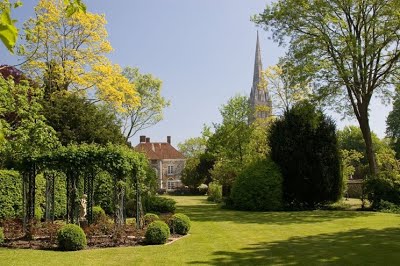
No. 538 JANUARY 2016 Edited by Sue Willetts
Happy New Year greetings to all members – best wishes for a healthy and happy year.
HADAS DIARY ***********
Tuesday 12th January, 8pm. Royal Palaces of Enfield. Lecture by Ian Jones (EAS)
Tuesday 9th Feb. 8pm. Medieval Middlesex – The Archaeological Remains by Adam Corsini.
Tuesday 8th March, 8pm. The Crossrail Archaeology Project. Lecture by Jay Carver.
Tuesday 12th April 2016, 8pm. In the lift to the beach: a visit to the Lundenwic waterfront by Douglas Killock
Tuesday 10th May, 8pm. Hadrian’s Wall: Life on Rome’s northern frontier. Lecture by Matt Symonds.
Tuesday 14th June 2016 ANNUAL GENERAL MEETING
Tuesday 11th October 2016, 8pm. Talk by Professor Caroline Barron. Title to be announced.
Tuesday 8th November 2016, 8pm. The Cheapside Hoard. Lecture by Hazel Forsyth
All the above events, unless otherwise stated, will be held at Stephens House & Gardens (formerly Avenue House), 17 East End Road, Finchley N3 3QE, starting at 8pm, with tea/coffee and biscuits afterwards. Non-members are welcome (£1.00). Buses 82, 125, 143, 326 and 460 pass nearby. Finchley Central Station (Northern Line) is a short walk away.
Tuesday 12th January, 8pm. Royal Palaces of Enfield. Lecture by Ian Jones (EAS)
This lecture by the author of a book with the same title will cover the two Royal Palaces in Enfield – Elsyng Palace, Forty Hall and Enfield Palace, Enfield, which were excavated between 1963 and 1982. The following details from the British and Irish Archaeological Bibliography database provide some background information. Elsyng is well documented from 1374: it was considerably rebuilt in 15th century and was a virtually self-supporting estate until it became dilapidated in 1650s. Excavation on the moat and part of one wing of the Tudor brick building showed 4-5 phases including Henry VIII’s of 1540s, but little of the total plan is known. Enfield Palace had a licence to crenellate in 1347 and much of the building survived into late 18th, the remainder being demolished in 1927. Excavation found some medieval and Tudor features but the palace itself underlies modern buildings; it can be largely reconstructed from surviving drawings and photographs.
Please come along to what will be an interesting first lecture in the HADAS calendar.
HADAS Christmas Party
Sunday 6th December saw the 5th HADAS Christmas Party in the Drawing Room at Avenue House with some 40 people enjoying themselves with much chatter and laughter and perhaps over-indulging in the splendid food cooked and set out by Malcolm Godfrey and his staff.
Our regular travellers appreciated a guest appearances from Ted, who came to confirm his approval of next year’s hotel for our long trip (More details elsewhere.) Also two bottles of Wroxeter Roman Wine made their annual appearance as raffle prizes.
Two table quizzes exercised the brain cells, the first being pictures of places within the Borough, and the second on General Knowledge to test knowledge about generals! Contact Jim Nelhams if you would like copies of the questions. The winning team was Henry and Marilyn Burgess, Kevin McSharry, Brenda Pershouse and Frances Radford.
The Nelhams duo supplied two musical numbers for further entertainment.
Sad news
It is with sadness that we report the death of Mike Purton, who belonged to the society for many years and with his wife Hilary came on several of the outings. We extend to Hilary our condolences on her sad loss.
We are also sorry to report that Shifra, Denis Ross’s wife, died recently. There was a large crowd at her funeral in Golders Green Crematorium on 16th December; HADAS was represented by Stewart Wild and Peter Pickering. Shifra was such a lovely person and our sympathies are with her family and friends.
HADAS wins Avenue House Quiz (Again)
Despite missing some of our regular team members, the Hadas team, alias “The Old Ruins”, succeeded in winning the regular Avenue House Quiz on Thursday 19th November. Our team of 7 was one of the smallest, one team having 12 members, but triumphed by a single point thanks largely to star performers Stephen Brunning and Simon Williams. If you would like to join our team at a quiz, or help make a second team, the dates for 2016 are 18th February, 12th May, 8th September and 17th November, all Thursdays.
New of the HADAS 2016 Long Trip
Our long trip will be from Monday 19th to Friday 23 September 2016 and will be based at BEST WESTERN Leigh Park Country House Hotel & Vineyard on the outskirts of Bradford on Avon, close to the Wiltshire/Somerset boarder. Likely visits are to Frome with its ancient streets, Devizes – on the Kennet and Avon Canal with two interesting museums, Wells for the Cathedral and Glastonbury Abbey with “the tomb of King Arthur”. Also on the list is the water wheel driven pumping station at Claverton and two medieval tithe barns.
Depending on numbers, the price may be slightly higher than in recent years – we have kept it below £500 per person for the last five years. During this time, the cost of coach hire has significantly increased and this cost is spread across all travellers.
More details and a booking form will come with a subsequent newsletter. It would be helpful in calculating the costs to know how many members, their partners and friends, are interested in coming on the trip.
Please let Jim or Jo Nelhams know if you want to be on the list. Contact details are on the back page of this newsletter
Lyndhurst Trip – continued:
Lyndhurst day 3
Having been unable to complete our schedule the previous day, a visit to Knowlton Church and Henge was omitted, so that we could spend more time in Salisbury. We had been advised that the archaeological gallery at Salisbury Museum was to be closed on this day for filming, but a late message advised that we could now visit. We made two stops before we went to Salisbury.
The Church of St. Mary’s, Breamore, Marilyn Burgess
This gem of a church was really worth a visit, and is reputed to be the most important Anglo- Saxon building in Hampshire. The building is late 10th century and reputed to have been built and financed by King Ethelred II, often referred to as Ethelred the Unready.
The Church of St. Mary and the village of Breamore were recorded in William the Conqueror’s Domesday Survey of 1085-6, when the church was already 80-90 years old. Three large royal estates existed in the area, the Manors of Damerham, Burgate and Rockbourne, the latter including Breamore.
An Augustine Priory was founded in about 1130, a little under a mile from the church. The Priory was dissolved in 1536 by King Henry V111. Eventually William Dodington gained possession of Breamore, and commenced the building of Breamore House in 1580. The Dodingtons retained Breamore until 1690, which was then transferred through marriage to the Brookes of Warwick Castle. In 1748, Sir Edward Hulse, physician to George II, purchased the estates and the family have remained there ever since, retaining Lordship of the Manor and, until late in the 20th century, the patronage of the church.
The church was remarkable in both its size and its advanced design. The building originally had a length of 120 feet or more as there was a western chamber. Today the surviving church measures 96 feet 6 inches. The church has many notable features, perhaps one of the most striking being an ancient Rood Screen, dated by historians as coming from the conquest.. This is seen from the porch, in the wall above the main door, and the two walls to each side. It features a carving of Christ hanging on the cross, and Mary and St John. A later medieval painting of a landscape background surrounds the carving.
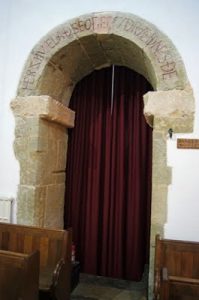
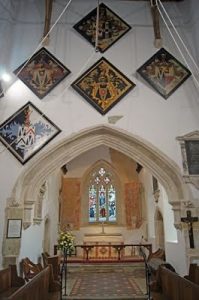 Another impressive feature is the arch leading from the tower to the South porticus. The arch carries a red- lettered inscription, in early eleventh century Anglo-Saxon script- HER SPV ELAD SEO GECPYDR EDNES DE, which translates to ‘Here is manifested the Word to thee’.
Another impressive feature is the arch leading from the tower to the South porticus. The arch carries a red- lettered inscription, in early eleventh century Anglo-Saxon script- HER SPV ELAD SEO GECPYDR EDNES DE, which translates to ‘Here is manifested the Word to thee’.
The crossing walls of the church are covered in hatchments, or funeral escutcheons, with the Coat of Arms of the Hulse family. There are 13 hatchments in total, 5 of which are on the arch leading to the high altar – probably the largest collection of funeral hatchments in any English parish church.
There are the remains of wall paintings on either side of the altar, and there are traces of other ancient paintings high above the east window. These paintings date from medieval times, but sadly are damaged and it is difficult to see what they represent.
The glass windows of the church come from different ages. Most are Victorian, and there is a recently installed window from the 20th century, commemorating those who died in the World Wars. There is also a large memorial board in the porch featuring the names of the men from Breamore, Charford and Woodgreen who went to the First World War. The board is an unusual feature, and those killed in action were marked with a ‘K’, and those wounded marked with a ‘W’.
This brief overview of St. Mary’s Church really does not do it justice, and it certainly warrants a further visit to take in more of its splendid features.
Rockbourne Roman Villa Audrey Hooson
Rockbourne Roman Villa is an interesting example of a long term, largely amateur excavation. It was discovered in June 1942 by farmer Tom Porter when he was digging out a ferret from a rabbit warren on West Park Farm and found oyster shells and tiles. A.T. Morley Hewitt of Fordingbridge, a local estate agent, chartered surveyor and antiquarian obtained permission for a trial dig in September 1942 and uncovered a mosaic pavement featuring an eight-pointed star.
He bought the land and following a feature on Southern Television in July 1960, which brought much interest and offers of help, regular excavation began.
The development phases are not easy to define, partly due to the fact that Morley Hewitt and his many helpers were learning their excavation techniques as they worked and did not record the stratigraphy in sufficient detail. They also had little interest in animal bones and pot sherds, some of which were discarded. Later, when the mosaic floors were lifted and reinstated by Ian Horsey of Poole museums, allowing further excavation, the Royal Commission on Historic Monuments was able to produce a report.
The earliest building was a small three-roomed house, there may have been a detached bath house. The midden contained pottery dating from AD100 – 150. By the mid-2nd century a building program began that continued for 250 years. A corridor villa was constructed to the west with a bath house and an aisled barn to the south east. Early in the 3rd century a new set of large rooms was built to the north, creating a winged corridor villa with hypocaust and a mosaic floored triclinium. From AD250 – 400 a detached bathhouse and additional farm buildings formed a courtyard villa.
Rockbourne then went into decline evidenced by broken mosaics, collapsing roofs and temporary fireplaces. Coin evidence suggests the crumbling structure was probably abandoned by AD420.
Over 70 rooms have been identified and excavated; at the height of the villa’s life about 40 were in use. Most of the excavation has been backfilled, leaving indications of the original walls etc.
There are several points of interest in the remaining conserved areas. In the west bath house one room has hypocaust supports constructed from upright imbreces, cemented together in pairs. In the east baths, where the first decorated floor with a star containing a central knot was found, an octagonal cold plunge pool had been cut in. Although they have no evidence for a garden a Roman garden is displayed.
Since 1978, the villa has been looked after by Hampshire County Council and is now part of their Arts and Museums Service. It has been developed as an excellent museum of Roman Life, probably intended largely for school visits. This enables the display of the many finds in sections such as daily life and bathing, entertaining and dining. Examples of pottery were Parchment ware, with red and orange designs, Black-burnished ware from Dorset and imitation Samian from Oxfordshire. There were also imported wares. In 1967 a New Forest pottery jar containing 7,717 bronze coins, covering 50 years and 21 Emperors was found (it was a precarious job) that was buried around AD 305. Unfortunately many of them have since been lost but about 500 are in the museum. Our visit to this small museum was quite a contrast to Stonehenge on the previous day.
Salisbury Cathedral Brenda Pershouse
The original Norman Cathedral stood on the hill at Old Sarum. The laying of the foundation stone of the new cathedral on 28th April 1220 was a remarkable venture using the new medium of Gothic architecture. Bishop Richard Poore, who had been active in the plan to move from Old Sarum, laid the first stone. The building of the new cathedral was greatly helped by the energy of the Bishop and the patronage of powerful people including King Henry III.
The spire, which stands at 404 feet, is the tallest in England. The still existing internal scaffolding was built of oak and was shown in a recent television programme on the life of an oak tree.
A glorious flower festival filled all corners of the building, with the theme of Magna Carta. Flower clubs from the neighbouring towns and villages contributed to this event. The theme was interpreted in many different ways, some imaginative, some artistic, and some not at all pleasing to the eye.
Salisbury’s copy of the Magna Carta is displayed in the cathedral Chapter House.
The Salisbury Museum Katie McGrath
This is situated in a medieval Grade I listed building called the King’s House, opposite Salisbury Cathedral. The collections span the entire prehistory and history of the Salisbury region representing every major period from the Palaeolithic (Old Stone Age) to the modern era.
When Sheila and I arrived at the Museum, having spent the previous two hours taking in the Cathedral, we were greatly relieved to sit and watch some lovely watercolour scenes of Salisbury painted by the artist, J M W Turner over 200 years ago, and to see the same scenes as they are today. There are so many collections at this museum including the Costume & Textiles collection made by or associated with local people, including samples of lace known as Downton Lace, named after a valley south of Salisbury, and which is still being taught and made today. The Ceramics and Glass collection includes a 3-tiered moneybox with slots for £ s & p. Beautiful porcelain figures from 18C, made locally, and as many as 650 pieces of Wedgwood, some made by Josiah Wedgwood himself! Relics of the ancient guilds of Salisbury abound in the museum, for example, Salisbury-made bells, clocks and watches, silver, guns and cutlery. There is even a pageant figure called the Giant and Hob-Nob made for the Tailors’ guild dating from 15C.
The greatest collection of all though is in the Wessex Gallery, which is in a new extension and was only opened as recently as May 2014. Here the archaeology collection spans 500,000 years with a range from flint tools to extravagantly decorated cremation urns, and from the simplest of pins to the most elaborate items of adornment. There are some wonderful examples of cathedral sculpture from Old Sarum (corbels). Lots of examples of Roman pottery found in south Wiltshire and made in the New Forest are exhibited. This area was ideal, as the raw materials for making ceramics were readily available. The remains of a Roman villa were found at Downton and the museum contains a mosaic showing a two-handled drinking cup (cantharus).
What was most interesting though was a Roman sarcophagus, 3C AD, known as the Amesbury Sarcophagus. This was found as recently as 2007 during excavation of a large Roman cemetery near Boscombe Down. When the lid was lifted, it was found to contain the remains of a woman who was holding a young child in her arms. Because moisture trapped within the sarcophagus had slowed down the processes of decay, they found that, even after 1800 years, the woman’s deer-skin slippers still survived. The child was buried wearing calf-skin shoes. The woman wore a necklace of Whitby jet, and on her right ankle was a silver and copper alloy bangle. By her head lay a pot imported from France. Unusually the lid was in two pieces and didn’t seem to fit – maybe the original lid had been accidentally broken.
Another interesting burial was that of the so-called Swallowcliffe Princess, Anglo-Saxon, 7C AD. This was found in a Bronze Age barrow on Swallowcliffe Down. A young woman aged 18-25 years, placed on a wooden bed and surrounded by artefacts, including a beautiful gold and silver satchel mount.
There is so much more I could write about this Museum, but space is limited, but I would urge you to go along and see for yourselves.
Arundells Kevin McSharry
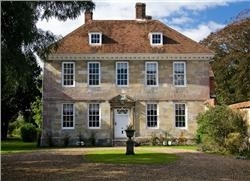 “Places explain people. They become impregnated with the spirit of those who have lived and been happy in them”. Bunny Garnett.
“Places explain people. They become impregnated with the spirit of those who have lived and been happy in them”. Bunny Garnett.
The above is certainly true of Arundells and its last owner and occupant Sir Edward Heath, former British Prime Minister and Elder Statesman.
Arundells is a delight. A beautiful detached, Georgian building with a large front garden and drive.
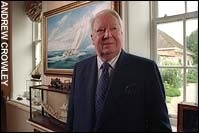 The interior of Arundells is suffused with light from its abundant sashed windows. Stylish yet homely and comfortable, full of the possessions of Sir Edward, Arundells reflects the interests and career of Ted Heath who lived and entertained there from 1985 until his death on 17th July 2005 – 20 years.
The interior of Arundells is suffused with light from its abundant sashed windows. Stylish yet homely and comfortable, full of the possessions of Sir Edward, Arundells reflects the interests and career of Ted Heath who lived and entertained there from 1985 until his death on 17th July 2005 – 20 years.
Politics, music and sailing were three of Edward Heath’s passions and Arundells is full of echoes, sounds and possessions that reflect a long life lived to the full. Arundells (parts dating back to the 13th century) derives its name from James Everard Arundel, a former owner, and scion of the Wardour Castle Arundels, an ancient recusant Roman Catholic family.
Samuel Johnson often declaimed, “Keep your friendships in good repair.” This dictum Sir Edward certainly adhered to, judging by the many photographs of his happy smiling friends who gather, even today, for reunions at Arundells.
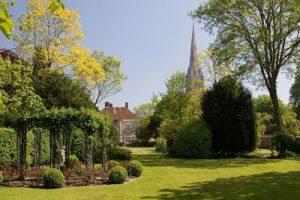 The two acre garden, designed in part, by Stuart Craven; the current Curator /Manager, is a horticulturalist’s dream. Stunningly designed with different vistas revealing themselves as one wanders its length to the Nadder and Avon rivers that flow just beyond its boundary. Strategically dotted throughout the garden are many benches & seats.
The two acre garden, designed in part, by Stuart Craven; the current Curator /Manager, is a horticulturalist’s dream. Stunningly designed with different vistas revealing themselves as one wanders its length to the Nadder and Avon rivers that flow just beyond its boundary. Strategically dotted throughout the garden are many benches & seats.
I imagined Sir Edward, stout and portly in old age, finding it difficult to stand for long or walk far, gently enjoying his garden moving from one seat to another.
The volunteer staff, which included his housekeeper, all seemed to have known Sir Edward. They have nothing but respect, love and admiration for him. They are fiercely protective of his reputation.
Arundells was left to the Sir Edward Heath Charitable Foundation for the enjoyment of future generations and for researchers and historians of politics and biography.
My dear brother Patrick (RIP) & I visited Salisbury a year ago with the VWSGB (Virginia Woolf Society of Great Britain) but Arundells sadly was not open. Patrick was a student of politics & biography. My visit fulfilled one of his ambitions. Arundells is a delight and a must to visit if one is ever in Salisbury.
Review of “A Hamlet in Hendon” in the London and Middlesex Archaeological Society (LAMAS) Transactions Volume 65 (2014) p. 320 by Eileen Bowlt, JP, BA, Chairman of the LAMAS Local History committee.
Reproduced in full with permission from the author and LAMAS
“Here we have a very well-produced [volume], presented with a dignified, but attractive front cover, bearing a coloured 1790 print of The Greyhound Inn with the tower of St Mary’s Parish Church peeping out behind; thus showing the centre of Church End, the hamlet of the book’s title. The site of the archaeological excavations at Church Terrace to the right of this picture. A selection of the varied finds, ranging from a Roman flagon with a face mask to a late 18th century saucer with a “precarious Chinaman” pattern, are depicted on the back cover. The story that lies between the covers lives up to expectations. The excavations at Church Terrace were undertaken in 1973-4 with great enthusiasm by members of the Hendon and District Archaeological Society (HADAS) founded in 1961 by Themistocles Constantinides.
Their earliest archaeological work started that year in the ruins of the nearby Church Farm, but had failed to find any trace of Saxon Hendon, which had been the main aim of the founder. Meanwhile a survey of the condition of the houses behind the church led Barnet Council to decide to demolish them and redevelop the area.
HADAS Research Committee began looking at historical documents to identify likely sites to excavate. All 85 diggers were amateur as opposed to professional archaeologists. A few were experienced in archaeological techniques, but most were not and learnt as the dig went on. The washing and marking of finds took a very long time. Significant artefacts were well researched and recorded. Assistance with identification came from British, London, Guildhall, and Reading Museums and also from the London and Middlesex Archaeological Society. Other finds were simply processed and stored in various places and had to be moved from time to time. Some were lost. Then in 2001 a series of HADAS/Birkbeck evening classes, led by Jacqui Pearce, was started to provide training in post-excavation analysis and led to the establishment of the HADAS Finds Group. In 2005, following the publication of the 1960s Church Farm dig, the Society decided to produce an archaeological biography of the Church Row Terrace site.
This splendid publication is the result. It is well written and contains material to please archaeologists, local historians and those who simply enjoy skimming through a book to look at the pictures. The first two chapters cover the background and the dig itself. The discovery of three burials near the churchyard wall caused some excitement and delay. The historical background, illustrated with plans, drawings and photographs, describes Church End period by period, interpreted by referenced archives and secondary material. The archaeology is divided into six periods from prehistoric and Roman to 20th century – and yes there were Saxons in Hendon. Excellent photographs of finds are bolstered by the occasional historic pictures. Beside a photograph of 17th c yellow bricks that were manufactured in the Low Countries, is a de Hooch painting showing similar bricks in a Dutch courtyard. One pit was filled with glass bottles, presumably from The Greyhound Inn. The illustrations in this section include a Hogarth print. There are six specialist reports, one being petrological, and chemical analysis of medieval pottery by the late Alan Vince. There is also one on coins and jettons, and another on clay tobacco makers recorded at Church Terrace.
This book is undoubtedly a good read. It takes a close look at a very small area, and the finds plus the documents consulted shed light upon the lives of earlier inhabitants, their occupations and their houses. It shows the benefits of modern techniques in the processing of archaeological finds, and also the interdependence of archaeology and documentary history, a lesson that is gradually being learnt on both sides and happily seen in recent reports published in these [LAMAS] Transactions.
It has been published by HADAS, a local society. The story is clearly told. The illustrations are good. There is an index, a bibliography and footnotes. It should serve as an example to other societies. Moral: it is never too late to publish.”
LAMAS comment as follows: Our thanks to Eileen Bowlt for such a thoughtful and interesting review. Her point is well made that archaeology and history are interdependent bedfellows when publishing archaeological excavations.
News on Enfield Museum and Local Studies Library – information taken from the Enfield Archaeology Society website where there are more details.
Enfield Council has announced the results of its consultation regarding the future of the Museum and Local Studies Library. Happily, the proposal to close the museum’s ground floor exhibition space at the Dugdale Centre has been scrapped, but most of the other proposals appear to be going ahead largely unchanged. While “drop in” access to the library will continue, consultation with the library staff will become by appointment only. Plans to digitise the archives will apparently go ahead, though details of these plans remain extremely vague.
Most worryingly, there remains no word on staffing and budget cuts to either service, which will have a profound impact particularly on how the museum is able to operate. The reduction of staff to one junior post and no operating budget will likely prevent the museum from staging any more of its successful and popular exhibitions, or any of its other public outreach activities.
We have offered the museum our support in maintaining a permanent display in the ground floor space of the Dugdale Centre, which will hopefully continue to showcase the history and cultural heritage of the London Borough of Enfield. It is sad that a council that so often pays lip service to our unique heritage assets should be so reluctant to invest in their presentation and curation.
Heritage Counts 2015 Don Cooper
Every year Historic England (formerly English Heritage) produces a pamphlet called Heritage Counts on behalf of the London Historic Environment Forum (LHEF) which contains inter alia statistics on Heritage in London. For instance; London’s heritage assets for 2015 are summarised as follows:
Asset type
2015
World Heritage sites
4
Scheduled Monuments
158
Listed Buildings Grade I
594
Listed Buildings Grade II*
1,399
Listed Buildings Grade II
16,943
Registered Parks and Gardens
150
Registered Battlefields
1
Protected shipwrecks
0
Conservation Areas
1021
Accredited Museums
134
Two interesting facts:
· London has the lowest concentration of listed building entries per capita. 2.3 entries per 1000 people (compared to a national average of 7.0 entries per 1000 people), but has the highest density of listed building entries with 12.0 entries per sq. km (compared to a national average of 2.9 listed building entries per sq. km.).
· London has just 1% of the national total of scheduled monuments.
Heritage Counts 2015 also carries out bespoke research. This year one of the pieces of research was “a survey of residential listed building owners”. The surveys finds that 92% consider their property to be very important, or important to the character of the local area.
78% felt that Listed Building Consent (LBC) is important to protect the architecture and special character of their property. 55% of them have lived their property for 10 years or more.
The survey also highlights the fact that Listed Buildings are expensive to maintain because finding the material and skill sets are costly. They would appreciate financial support in the form of VAT exemption or other support. There are lots of other interesting articles on heritage in London. Hard copies of the Heritage Counts 2015 London report can be ordered from Historic England Customer Services on 0370 333 0607.
Other Societies’ Events (includes a few not included in the last newsletter) by Eric Morgan
Friday 15th January, 7.30 pm Wembley History Society. English Martyr’s Hall, Chalkhill Rd, Wembley, HA8 9EW. My little piece of history. Talks by society members. Visitors £3.
Wednesday 20th January, 7.45pm. Edmonton Hundred Historical Society/ Joint meeting with Enfield Society. Jubilee Hall, 2 Parsonage Lane, Enfield, EN2 OAJ. The Real Dad’s Army. Talk by Mike Brown with WW2 artefacts. £1.
Tuesday 26th January, 10.30am Enfield Society. Jubilee Hall, (address above) A parish re-united: a story of the Clay Hill area. Talk by Roger Elkin. Refreshments
Wednesday 27th January, 7.45pm Friern Barnet and District Local History Society. North Middx Golf Club, The Manor House, Friern Barnet lane, N30 ONL Garden cities. Talk by David Berguer (Chair). Visitors £2. Refreshments & bar.
Thursday 4th February, 7.30pm London Canal Museum, 12-13 New Wharf Road, King’s Cross, N1 9RT. Industry in the Lee Valley. Talk by Jim Lewis (Author) £4 or concessions £3.
Thursday 4th February, 10.30am Pinner Local History Society, Village hall, Chapel Lane Car Park, Pinner. My life I the Foundling Hospital School. Talk by Lydia Carmichael. Visitors £2
Sunday 6th February, 10.30am Heath and Hampstead Society. Meet outside Brew House Café, Kenwood House, off Hampstead Lane, NW3 7JR. The Heath and Kenwood: How they relate to each other. Walk led by Thomas Radice, (H & HS Trustee). Lasts approx. 2 hours. Donation £4.
Monday 8th February, 3pm Barnet Museum and Local History Society, Church House, Wood St, Barnet. Jean Rhys: a woman in the attic. Talk by Jackie Leedham
Wednesday 10th February, 2.30 pm Mill Hill Historical Society, Trinity Church, The Broadway, NW7. The history of public parks. Talk by Letta Jones
Saturday 13th February, 11am-3pm. North London & Essex Transport Society. Barnet Transport Fair. Christ Church Hall, St. Alban’s Road, Barnet, EN5 4LA. Bus, railway, aviation & military transport – books, photographs, DVDs, time-tables, maps etc Admission £2. Refreshments
Monday 15th February, 8.00 pm. Enfield Society, Jubilee Hall, 2 Parsonage Lane, Enfield, EN2 OAJ. A pictorial journey around Southgate. Sound colour films of Southgate in the 1950’s & 60’s showing historical buildings, transport, parks & events. Introduced by Louise Pankhurst (Archivist)
Friday 19th February, 7.30 pm. Wembley History Society. Address above. An introduction to Bletchley Park. Talk by Denis Falvey. Visitors £3 refreshments in the interval.
Wednesday 24th February, 7.45pm Friern Barnet and District Local History Society. Address as above. Time for tea: a history of tea drinking in London. Talk by John Neal. Visitors £2. Refreshments & bar before and afterwards.
Thursday 25th February, 2.30 pm. Finchley Society. Drawing Room, Stephens (formerly Avenue) House. 17 East End Road, Finchley N3 3QE. Talk on Aspects of Old Friern by Pauline Ashbridge. Non members £2. Refreshments at 2pm and afterwards.
Acknowledgements: Thanks to our contributors: Eileen Bowlt, Marilyn Burgess, Don Cooper, Audrey Hooson, Eric Morgan. Kevin McSharry

